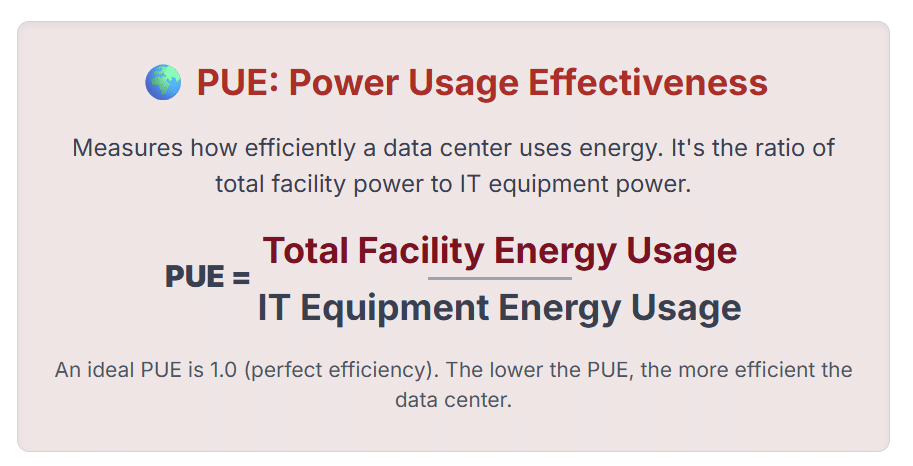Understanding Power Usage Effectiveness in Sustainable Data Centers
Published on February 20, 2024,
by
Data center power efficiency is a cornerstone of sustainable IT operations. Power Usage Effectiveness (PUE), developed by The Green Grid, is the leading metric for evaluating how effectively a data center uses energy. By comparing total facility power to the energy consumed by IT equipment, PUE provides a clear picture of operational efficiency and environmental impact. As demand for digital infrastructure grows, optimizing PUE is essential for reducing costs and achieving sustainability goals.
The Significance of PUE
PUE measures the total power consumption of a data center, juxtaposing it against the power used by the IT equipment that drives the core functions of the facility. This ratio not only illuminates the energy efficiency of a data center but also its sustainability footprint. With data centers in the United States accounting for 2% of the country's total electricity usage—a figure set to escalate alongside the growing thirst for data processing—understanding and optimizing PUE is more critical than ever.
The Cost of Inefficiency
Data centers are notorious for their hefty energy appetites, driven by an array of servers, storage systems, networking gear, and the cooling mechanisms required to keep them all running smoothly. However, not all energy consumed contributes directly to data processing. Underutilized servers, for example, squander energy and physical space, while power-hungry hardware strains cooling systems, leading to a vicious cycle of inefficiency and elevated operational costs.
Calculating PUE: A Closer Look
The PUE metric is derived by dividing the total facility power—encompassing all energy consumed within the data center, including cooling, power delivery, and lighting—by the power used solely by IT equipment like servers, storage, and networking devices. A data center's PUE score directly reflects its energy efficiency: the closer the score is to 1, the more efficient the facility is deemed to be. Conversely, a high PUE indicates excessive non-IT energy use, signifying inefficiency, reduced sustainability, and higher operational costs.

The Path to Sustainability
Achieving a low PUE is not merely about reducing costs; it's a commitment to sustainability. In an age where environmental responsibility holds increasing weight, data centers with optimized PUE scores demonstrate a dedication to minimizing their carbon footprint. This involves refining IT equipment's efficiency and innovating in cooling systems, power delivery architecture, and even building design.
Beyond PUE: A Holistic Approach
While PUE is an invaluable tool in the quest for data center efficiency, it's part of a broader ecosystem of sustainability practices. Renewable energy sources, waste heat recovery, and advanced virtualization technologies all play pivotal roles in pushing data centers toward a greener future. Moreover, as the digital landscape evolves, so too must the methodologies for measuring and achieving efficiency in these critical infrastructures.
Conclusion
In the digital age, the importance of sustainable data centers cannot be overstated. PUE serves as a crucial metric in this endeavor, guiding operators in identifying inefficiencies and paving the way for more sustainable, cost-effective operations. As the demand for data processing continues to climb, the role of PUE in fostering environmentally responsible data centers will only grow in significance, underscoring the need for continuous innovation and commitment to efficiency in the data center industry.
Additional Resources
White Paper: Fundamental Measures of Data Center Sustainability
Executive Brief: Climate Risk Disclosures in Data Centers - A Review of the Proposed SEC Guidelines
Executive Brief: Singapore's Data Centre Energy Efficiency Scheme (DCS)
What is PUE and how is it Calculated? | Nlyte
